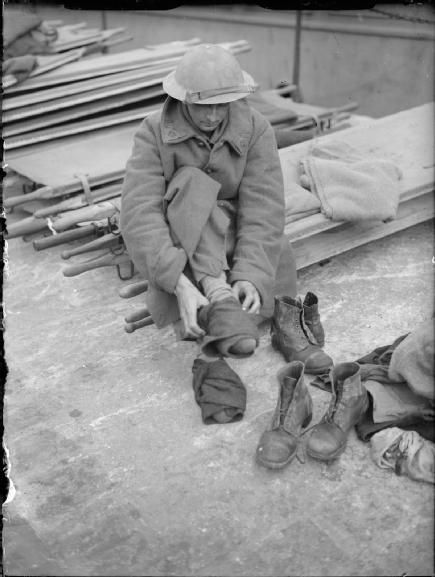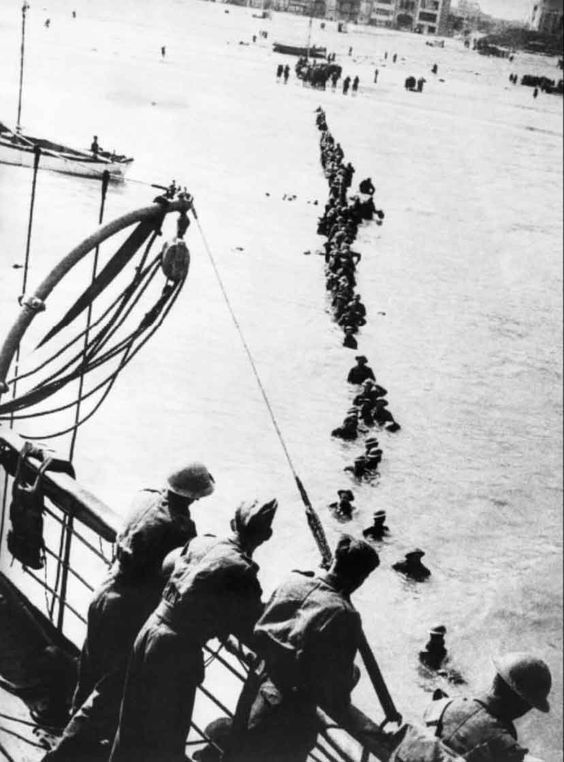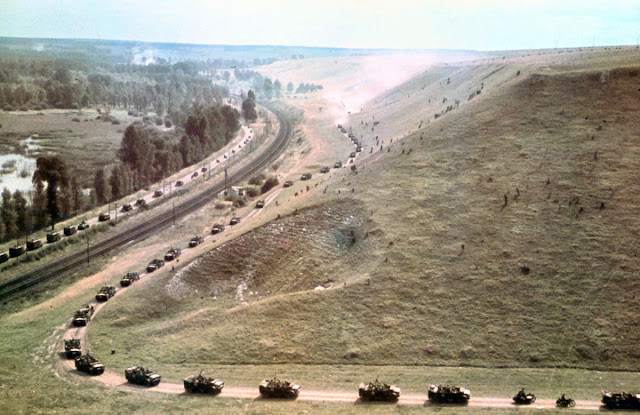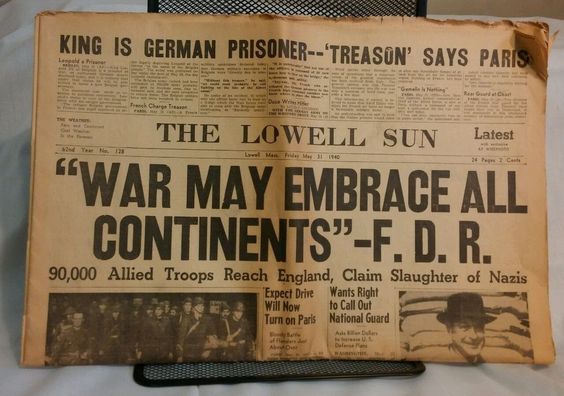Monday 9 September 1940
 |
| Near London Bridge in London, 9 September 1940 (AP). |
Instead, the Luftwaffe doubles down. The command staff at the Luftwaffe high command (OKL) organizes the attacks, suggesting they are not going to stop any time soon. Night raids will be carried out by Luftflotte 3 and day raids by Luftflotte 2. London is divided into different sectors for bombing priority, Area A being the East End and dock, Area B being the power stations and other priority installations in West London:
The maintaining of the attack against London is intended to take place by day through Luftflotte 2 with strong fighter and destroyer units; by night Luftflotte 3 will carry out attacks with the object of destroying harbor areas, the supply and power sources of the city. The city is divided into two target areas, the eastern part of London is target A with its widely stretched out harbor installations. Target area B is the west of London, which contains the power supplies and the provision installations of the city. Along with this major attack on London the destruction raids will be carried on as much as possible against many sectors of the armament industry and harbor areas in England in their previous scope.This order confirms and codifies the new change in objectives. The armaments industry is mentioned only in passing, and RAF airfields and radar stations not at all.
In addition, the OKL begins to recognize that the RAF is far from defeated. It issues orders that any formation facing strong opposition is allowed to break off contact and head home.
Meanwhile, Wehrmacht Army Commander-in-chief Field Marshal Walther von Brauchitsch, looking ahead, drafts a plan for the occupation of Great Britain. It is an extremely harsh plan which foresees deporting all males 17-35 years of age to the continent for forced labor and basically robbing the British of their goods and industry.
Germany announces an unrestricted war zone around the British Isles.
Around this time, a German crew spends two days filming practice landings by the Kriegsmarine of troops and tanks near Antwerp. The objective is to have footage of the invasion available for the newsreels, the theory being that a landing at night can't be filmed.
 |
| British infant, Margaret Curtis. Published in the 9 September 1940 Life Magazine. |
Air Vice-Marshal Keith Park in command of No. 11 Group covering southeast England decides that the Luftwaffe has shifted to a new pattern of attacking London beginning in mid-afternoon and long into the night. He shifts his squadrons to forward airfields along the expected line of attack and has two dozen fighter squadrons ready for action.
Around 17:00, the Luftwaffe finally sends over its main attack for the day. A fleet of about 300 aircraft approaches near Foreland. It appears to be a repeat of the attack on the 7th. The RAF fighters skip the Luftwaffe fighters leading the advance and rise to meet the bombers coming after them.
RAF No. 607 Squadron from RAF Tangmere just east of Chichester is the first to attack, and it is the squadron's first combat. It turns out badly, as it loses half a dozen Hurricanes, with the Germans losing only one bomber to it.
RAF No. 303 Squadron has better luck. The Polish squadron shoots down a couple of Bf 109s and a Bf 110. Sergeant Josef František shoots down one of the Bf 109s.
The bombers make it over London, and massive dogfights break out over the Houses of Parliament and the docks nearby. Squadron Leader Douglas Bader of No. 12 Group with his "Big Wing," ordered to protect the airfields at Hornchurch and North Weald, defies orders and instead heads down to the action, where his planes do a lot of good.
Some of the bombers make it over London to drop their bombs. However, many more bombers heed the OKL orders and drop their bombs at random to no purpose and head for home.
Two Bf 109s from JG 27 (Gruppe-Adjutant Oblt. Günther Bode of Stab I,/JG 27 and Oblt. Erwin Daig, the Staffelkapitän of 5,/JG 27) are forced down after their radiators are hit and the engines overheat. This gives the British two virtually intact German fighters. These are put on display, then join the RAF "Ratwaffe."
After dark, Sperrle's Luftflotte 3 sends bombers across the coast near the Isle of Wight, heading toward London. They cause the major damage of the day in several neighborhoods, including near the Bank of England and Cheapside. A bomb hits a school being used as a shelter for homeless people near the historic Somerset House, just east of Waterloo Bridge in central London, killing 370 and injuring 1400. A women's hospital is bombed, and the East End docks area suffers tremendous damage. The raids last all night, the source moving from France north to the Dutch islands, finally ending around 05:00 on the 10th.
The score for the day is slightly in favor of the RAF, but it is fairly close. Most estimates put the Luftwaffe losses around 25 planes and RAF losses around 20. The Luftwaffe bombers, however, accomplish little, particularly to prepare for an invasion.
There is an exchange of gunfire by the big coastal guns at Hellfire Corner (Dover/Cap Gris Nez) during the evening.
Commander of No. 242 Squadron Douglas Bader downs a Dornier Do 17. Afterward, spotting a Heinkel He 111, he tries to shoot it down but realizes he is out of ammunition. He then rams the plane, slicing off its rudder, before turning away.
Kommodore Major Werner Mölders of Stab,/JG 51 shoots down a Spitfire over London for his 35th victory. Oblt. Gerhard Schöpfel of 9,/JG 26 shoots down three Spitfires of No. 92 Squadron over the Thames estuary. Oberleutnant Helmut Wick is promoted to Hauptmann and now is the Gruppenkommandeur of I,/JG 2, while Hptm Franz-Heinz Lange becomes Gruppenkommandeur of II,/JG 77
Fähnrich (officer candidate) Hans-Joachim Marseille receives the Iron Cross Second Class for his second air victory.
 |
| London, 9 September 1940. All of the passengers and the driver heard the air raid sirens and sought shelter before the bombs hit. |
Battle of the Atlantic: It is a busy day at sea. U-boats have been gathering in a wolfpack around Convoy SC 2 northwest of County Donegal, Ireland/southwest of Barra, Outer Hebrides. U-47 (Kapitänleutnant Günther Prien) already has several victories against the convoy, and today he strikes again.
U-47 torpedoes and sinks 3840 ton Greek sulfur phosphate freighter Poseidon at 00:24. There are ten survivors and 7 crew perish (some accounts say all were lost).
U-28 (Kptlt. Günter Kuhnke) also is shadowing Convoy SC-2. At 04:47, it torpedoes and sinks 2434 ton British pitch freighter Mardinian (Master Joseph Every). The ship takes 30 minutes to sink, giving most of the crew time to get off. There are 32 survivors and six crew perish.
Some ships in London become victims of the Luftwaffe raids there.
British 5046 ton freighter Minnie de Larrinaga is bombed and sunk in London. Destroyed by fires, she is a total loss, but since she is sunk in such shallow water, her hulk can (and must, for the continued operation of the dock) be salvaged (some accounts say this sinking happened during the first big London raid on 7 September). Ultimately, it is dragged out and used as a blockship at Dover.
The Luftwaffe also sinks 8,663-ton British freighter Baronesa at its dock in London. It already was damaged by E-boat attacks in the North Sea while with Convoy FS 271. The damage is not too great, and the ship can be salvaged.
The Luftwaffe also damages the 695-ton Belgian freighter Anna at Russia Dock, Surrey Docks in London.
The Luftwaffe damages British 367-ton freighter Ryal at its London dock.
Destroyers HMS Vanoc and Viscount collide at Plymouth, causing minor damage.
Italian submarine Comandante Faà di Bruno damages 8030 ton British Shell tanker Auris off the Azores 750 miles west of Gibraltar. Large tankers are very difficult to sink by torpedo due to their construction, and the Auris makes it to port.
The Royal Navy, concerned about a prospective invasion, resorts to sinking old and damaged ships at harbor entrances as blockships.
Small 56 ton British cargo ship Alfred Colebrooke is sunk as a blockship at Richborough (Dover), Kent. In addition, British trawler Harvest Moon also is sunk there as a blockship.
Royal Navy trawler HMT Dervish, requisitioned by the Admiralty in June (as it had been during World War I), hits a mine and sinks at the mouth of the Humber near Spurn Point. There are 11 survivors and 4 crew perish.
Royal Navy trawler HMS John Baptist also hits a mine and sinks, this one south of the Conningbeg Lightship off Wexford's Saltee Islands.
German raider Widder, having captured Greek collier Antonios Chandris in the mid-Atlantic on the 8th, plants demolition charges and scuttles it at dawn. The crew of the freighter, set adrift on lifeboats hundreds of miles from land, is adrift until 8 October.
British Fleet Air Arm Skuas are sent from their base at Royal Naval Air Station Hatston, Orkney, Scotland to attack shipping at Bergen, Norway. One of the Skuas is lost, with two dead.
The first eight former US Navy destroyers transferred to the Royal Navy pursuant to the destroyers-for-bases deal become Her Majesty's Ships:
- Caldwell,
- Cameron,
- Campbeltown,
- Castletown,
- Chelsea,
- Chesterfield,
- Churchill, and'
- Clare.
German minelayers continue laying a minefield in the southwest portion of the North Sea as part of Operation Hannelore.
A new floating dock, the Admiralty Floating Dock, goes into operation at Scapa Flow. Its first ship is destroyer HMS Bedouin.
 |
| The Daily Mail, 9 September 1940. |
The Italian equipment is inferior, most noticeably in the lack of adequate transport to support the advance. The Regia Marina only has about 300 combat airplanes total in the theater, though more planes can be dispatched from Italy across the Sicilian Narrows.
There is no ground combat today (apparently the Italians don't even cross the border yet), but the RAF swings into action. RAF Nos. 55, 113 and 211 Squadrons raid both the advancing troops and airfields in Italian Libya. Italian aircraft bomb British defensive positions ahead of the advance and make a fighter sweep by 27 CR. 42s over Buq Buq. There are unusual dogfights over the desert involving biplanes on both sides, Regia Aeronautica Fiat CR.42 Falco fighters and RAF Gladiators.
HMS Illustrious and Eagle send aircraft against the Italian bases on Rhodes. The latter carrier loses four aircraft.
At Malta, there are no air raids. The Royal Navy only has one minesweeper, HMS Fermoy, in operation, and the local government requests two more from the Admiralty.
Battle of the Indian Ocean: German raider Atlantis, disguised as Dutch freighter MV Tarifa, tries to stop empty 9557-ton British tanker Athelking about 1200 miles east of Madagascar. When the tanker refuses to stop and opens fire, the Atlantis disables it with its own vastly superior gunfire. There are six deaths. After taking whatever supplies and documents it can from the tanker and making the remaining crew POWs (40), the Atlantis uses the tanker as target practice and sinks it.
The Athelking manages to send a distress call that is received at the Royal Navy East Indies station at Colombo. The Admiralty sends cruisers HMS Neptune and Capetown and several smaller ships to track down the raider.
Anglo/US Relations: The US transfers eight submarines to the British Royal Navy at Halifax, Nova Scotia.
Anglo/Vichy French Relations: Vichy French military intelligence gets wind of the coming attack on Dakar (Operation Menace) by the British. To reinforce the forces there, the French send cruisers Montcalm, Gloire, and George Leygues, escorted by torpedo boats Fantasque, Malin and Audacieux, from Toulon. They head toward the straits of Gibraltar en route to Dakar. Given that the British and Vichy French already have engaged in combat in the Mediterranean, this sets the stage for a tense situation, as the French ships literally will be sailing within sight of the British base at Gibraltar.
War Crimes: In Treznea, Sălaj, the handover of Northern Transylvania goes very badly. There are roughly 93 deaths during the Treznea massacre. There are varying versions of the incident, with the Hungarians claiming that an uprising was started by a local Romanian Orthodox priest, and the Romanians claiming that many of the local (minority) Hungarians participated in the incident and instigated the situation in hopes of taking sole possession of the region - and perhaps getting a little revenge for past perceived slights. Local Romanians are taken to a nearby cliff and machine-gunned, but the Hungarians stop when retreating Romanian army units are called. Needless to say, this inflames tensions between the two nations that already are red hot.
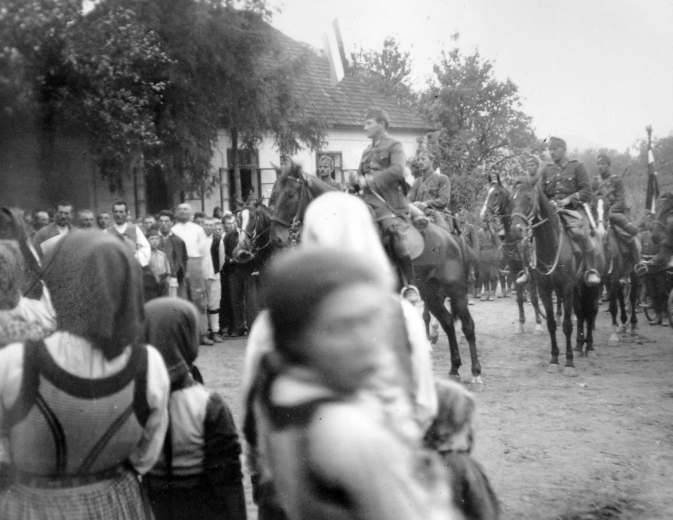 |
| Hungarian troops entering Transylvania, September 1940 (Source: Fortepan). |
In addition, the Italians start trying something that will be a recurrent theme throughout the war: appealing to local ethnic/religious resentments as a motivating tool. Leaflets are dropped on Jaffa to promote the idea that Palestinian Arabs will become free if they join the Axis war effort. In fact, there is tremendous sympathy for the Axis throughout the Arab world for several different reasons, so these leaflets drop on fertile ground (so to speak). The British administer Mandatory Palestine, but the obvious subtext is an appeal to anti-Semitic/anti-British groups such as the Black Hand. They have been causing problems for the British for years, most significantly during the Arab Revolt of 1936-1939.
 |
| This fine fellow as "annoying children in Central Park" and the cops roughed him up a bit to teach him a lesson. Back when cops taught miscreants a thing or two personally. |
Free France: French forces in India join the Free French movement.
US Military: With a new $5 million appropriation available, the US Navy places orders for seven battleships, 12 aircraft carriers, and 191 additional ships.
Colonel Carl Spaatz, having completed his tour as a special military observer in England, departs for the US via Lisbon to become an assistant to the head of the Army Air Corps, with a promotion to Brigadier General.
US Secretary of the Navy Frank Knox, on tour of naval operations in the Hawaiian Islands, visits the USS Enterprise.
German Homefront: Berliners are instructed to sleep dressed and to go to bed early so that they can get in some sleep and then run to the shelters should bombers appear overhead at midnight as usual.
September 1940
September 1, 1940: RAF's Horrible Weekend
September 2, 1940: German Troopship Sunk
September 3, 1940: Destroyers for Bases
September 4, 1940: Enter Antonescu
September 5, 1940: Stukas Over Malta
September 6, 1940: The Luftwaffe Peaks
September 7, 1940: The Blitz Begins
September 8, 1940: Codeword Cromwell
September 9, 1940: Italians Attack Egypt
September 10, 1940: Hitler Postpones Sealion
September 11, 1940: British Confusion at Gibraltar
September 12, 1940: Warsaw Ghetto Approved
September 13, 1940: Zeros Attack!
September 14, 1940: The Draft Is Back
September 15, 1940: Battle of Britain Day
September 16, 1940: italians Take Sidi Barrani
September 17, 1940: Sealion Kaputt
September 18, 1940: City of Benares Incident
September 19, 1940: Disperse the Barges
September 20, 1940: A Wolfpack Gathers
September 21, 1940: Wolfpack Strikes Convoy HX-72
September 22, 1940: Vietnam War Begins
September 23, 1940: Operation Menace Begins
September 24, 1940: Dakar Fights Back
September 25, 1940: Filton Raid
September 26, 1940: Axis Time
September 27, 1940: Graveney Marsh Battle
September 28, 1940: Radio Belgique Begins
September 29, 1940: Brocklesby Collision
September 30, 1940: Operation Lena
2020


